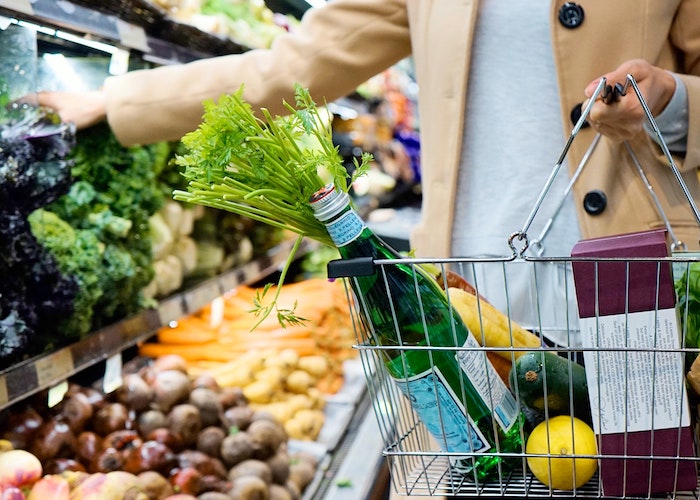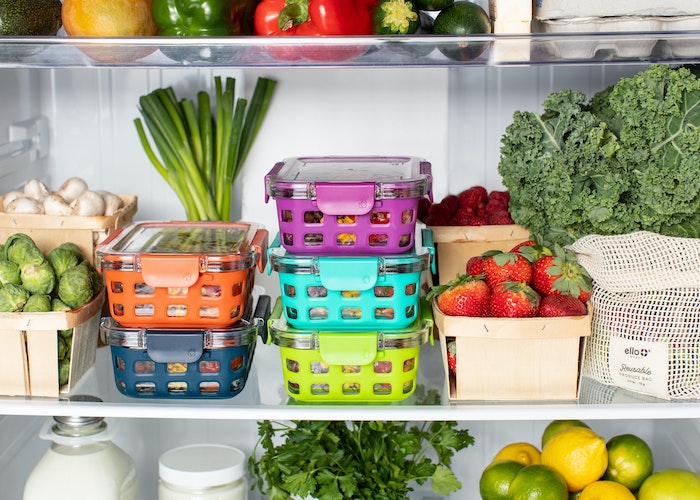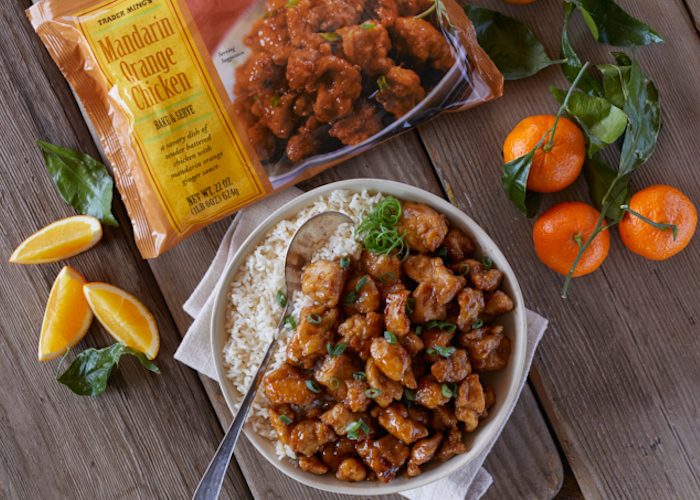4 Steps I Follow To Save Money On Organic Groceries (No Coupon Clipping Required)

Have you ever unloaded your groceries after a trip to the store and thought to yourself, That’s it? That small pile of food cost me $100? That used to happen to me all the time, and it was a terrible feeling.
About 80% of my diet consisted of high quality, fresh foods (the other 20% was reserved for Taco Bell and mimosas). And let’s be honest: good quality food can get expensive. My goal was to figure out how to buy the exact foods on my shopping list for less without having to spend a ton of extra time clipping coupons or bargain hunting every week. That’s when my mother bought me a membership to Costco, a wholesale warehouse store. Initially, I was skeptical. Like many others, I assumed shopping wholesale meant buying gallon-sized jars of mayonnaise and slabs of meat large enough to feed a football team. I had this preconceived notion that wholesale stores simply wouldn’t fit the needs of my two-person family. Turns out I was wrong.
For starters, anyone can benefit from wholesale stores, whether shopping for one person or a family of eight. It is all about buying the right foods and storing them efficiently. Strategically shopping at wholesale stores has enabled me to regularly purchase a variety of high-quality organic foods at a fraction of the price of other grocers. However, saving money at wholesale stores is more complex than buying things at low prices and calling it “savings.” Shopping wholesale is only a viable money-saving solution with the right buying strategy.
How to Optimize Your Buying Strategy
Follow the four steps outlined below to optimize your buying strategy and guarantee yourself significant savings. The overall goal is to buy what you need, use what you buy, and avoid waste without over-consuming.
Step 1: Select the right foods.
- Do purchase foods you eat regularly. Avoid purchasing foods you have never tried or rarely eat. If you don’t like something or rarely use it, you’ll likely throw it away.
- Do purchase healthy foods. Do not purchase unhealthy/highly processed foods like packaged snacks, chips, pop, sweets and frozen meals. Buying unhealthy foods in large quantities often causes overconsumption and needless spending. Think of it this way: sentences like “potato chips are so addicting I ate the entire bag” have likely been muttered by every person who has ever tried a potato chip. However, no one has ever said, “Spinach is so addicting I ate the entire bag.” See where I’m going with this? To keep your waistline from expanding and bank account from shrinking, avoid stocking up on unhealthy foods.
- Do purchase foods with a long shelf life. Examples include foods that are dried, canned, bottled, vacuum-sealed or frozen. This is where one and two-person households can achieve significant savings.
- Do purchase pre-frozen meat, poultry, fish and other seafood. Each piece is frozen individually, which means you can grab only as many shrimp, breasts, filets, etc. as you need.
- TIP: If you’ve ever put a package of fresh chicken breast in the freezer to save for later, you know that thawing a giant frozen brick of 3 or 4 chicken breasts is a drawn-out nightmare. This is why I recommend buying protein pre-frozen instead of freezing it yourself. The only exception is if you are willing to put in the time and effort to portion out protein and freeze each portion individually.
- Do purchase some fresh produce, but only as much as you’ll eat within a week. (Unless you plan on freezing it.) If you save a bunch of money on a big bag of spinach but throw half of it away, you didn’t really save anything.
- TIP: If you’re new to wholesale shopping, I recommend starting with 2-3 fresh fruits and vegetables to avoid waste. Over time, you will figure out how much you can eat and different ways to incorporate more fresh fruits and veggies into your diet. When I first started shopping wholesale, I would buy 1-2 fresh fruits/vegetables but now I buy 6-9.
Step 2: Take a few minutes to prepare for your trip.
- Do make a list and stick to it. This is the single most important part of the buying strategy. If you do not make a list, low prices and shiny new things will cause you to make impulse purchases. Then two hours and $800 later, you will find yourself wondering how you ended up with a new flat screen TV and a trunk of stuff you don’t need and likely won’t use.
- Do put things on your list you regularly purchase at the grocery store. The only way wholesale stores actually save you money is if you are replacing grocery store purchases with wholesale purchases. If you normally wouldn’t buy a particular item at the grocery store, it is likely an extra expense and won’t actually save you money.
- TIP: Review your grocery store receipts/purchases from the past few months. Highlight the things you bought regularly to use as a starting point for your wholesale shopping list.
- TIP: Putting together your wholesale shopping list can take less than a minute if you set up your own system. Keep a Master Wholesale List of all the foods you buy at wholesale stores. A Master List allows you to track what you need and prepare for your trip in seconds rather than minutes. See this article for recommendations and an actual example of one of my wholesale shopping list.
Step 3: Shop responsibly.
- Do know general prices or bring your phone to price check. Although most items are a good deal, there are a few that aren’t. If you aren’t sure about something, do a quick price check on your phone.
- TIP: If you are shopping at Costco, Kirkland Brand products are almost always a safe bet. Their prices are pretty hard to beat.
- Do not purchase something because it is a good deal. Low prices make it easy to justify impulse purchases. Ask yourself why you’re buying something. If your response is anything remotely close to “It is such a good deal!” or “I could find a use for this!”, walk away immediately. It is a money-wasting trap.
- Do not under any circumstances go to a wholesale store hungry. Although this is a general grocery shopping rule, I want to really emphasize this for wholesale trips because the consequences are far graver. Trust me.
Step 4: Store food efficiently.
- Do not keep foods in original bags and boxes with excess packaging. Excess packaging creates chaos because you can’t see exactly what you have. If you can’t see it, you won’t eat it and won’t save money.
- TIP: Storing fresh fruits and vegetables directly in your line of sight will entice you to eat them more often.
- Do remove foods from their packaging. Store them in organized, uniform and stackable containers/Tupperware. This takes a small amount of time upfront but saves a huge amount of time, money and frustration later on. Not to mention your pantry and fridge will be beautifully organized.
- TIP: If your Tupperware drawer is a frustrating pile of mismatched containers, I recommend replacing them with deli containers. Deli containers come in various sizes but every size uses the same size top, which keeps Tupperware drawers simple and organized. The shape and stackability of the containers enable you to store more food with less space.
- Do designate storage locations in your fridge and pantry for specific food items. Storage is less about space and more about organizing. When stored efficiently, the quantities of food sold at wholesale stores take up far less space than you might think. In order to use everything you buy and avoid waste, efficient and effective storage is essential. This article explains efficient storage with a simple 4-step process.
- TIP: If storage space is a concern, use the “Now and Later” storage strategy to efficiently store large quantities of food:
- Now Storage is where food is stored for daily use. This should be an easily accessible cabinet or shelf in your kitchen. Store only the amount of each food you’ll use in the next couple weeks.
- Later Storage is where you store the remaining portions of food/ingredients. It doesn’t have to be as convenient because it is only accessed once every week or so to replenish the Now Storage. In fact, it doesn’t even have to be in the kitchen. It could be anywhere in your home.
- TIP: If storage space is a concern, use the “Now and Later” storage strategy to efficiently store large quantities of food:
Anyone, even those shopping for one, can save money on healthy high-quality foods by following this four-step buying strategy. It’s as simple as selecting the right foods, making a list, shopping responsibly, and storing food efficiently. Below are additional resources to help maximize savings, simplify storage and promote a healthy lifestyle:
- Cost, Quality, and Quantity: What Wholesale Shopping Actually Looks Like
- Mini Guide to Healthy Grocery Shopping at Costco
- A Simple but Life-Changing Tupperware Update
- How My Fridge Went From Chaos to Organized Perfection in 19 Minutes
- Portion Control Guide: Five Quick and Effective Strategies You Can Use Today
Rachel is a former CPA and current online entrepreneur. With a simplified approach to food, she helps others fit a healthy diet into their lifestyle. See ZestedLemon.com for recipes, healthy articles, and free resources.
Image via Unsplash




